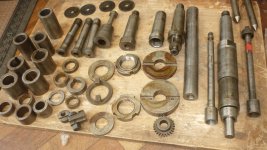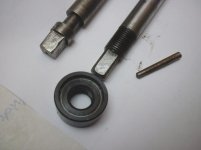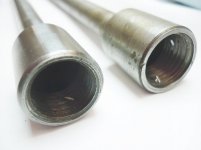bob531
Aluminum
- Joined
- May 9, 2015
- Location
- U.K Cumbria
Hi ,
Bit of a silly question but im confused by my drawbars that came with my alexander. Its the mt4 spindle but i have two draw bars ,one has a collar that threads on and had a taper pin taped to it (this one looks like a proper one), The second one i have is totally different and just has a square head top and no collar .It is also a touch longer and has obviously been joined /welded or repaired at some time..
I havent managed to use the mill much yet but i am getting more time at the moment .
Also are the drawbars supposed to eject mt4 tooling with the s20 thread or what is the correct way to use them????
I also have some mt4 tooling that has a longer taper than the original alexander stuff with various threaded sizes like m16 or 5/8" ??? Will long tapered tooling have to be cut down somehow in order to use it in the vertical head?
Photo attached of the two drawbars i got with the mill.

Bit of a silly question but im confused by my drawbars that came with my alexander. Its the mt4 spindle but i have two draw bars ,one has a collar that threads on and had a taper pin taped to it (this one looks like a proper one), The second one i have is totally different and just has a square head top and no collar .It is also a touch longer and has obviously been joined /welded or repaired at some time..
I havent managed to use the mill much yet but i am getting more time at the moment .
Also are the drawbars supposed to eject mt4 tooling with the s20 thread or what is the correct way to use them????
I also have some mt4 tooling that has a longer taper than the original alexander stuff with various threaded sizes like m16 or 5/8" ??? Will long tapered tooling have to be cut down somehow in order to use it in the vertical head?
Photo attached of the two drawbars i got with the mill.











